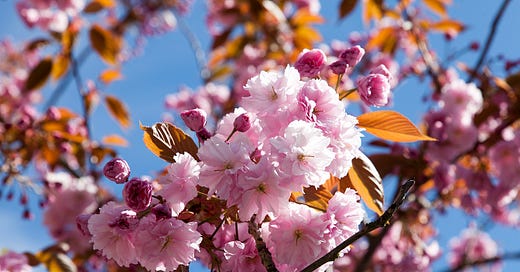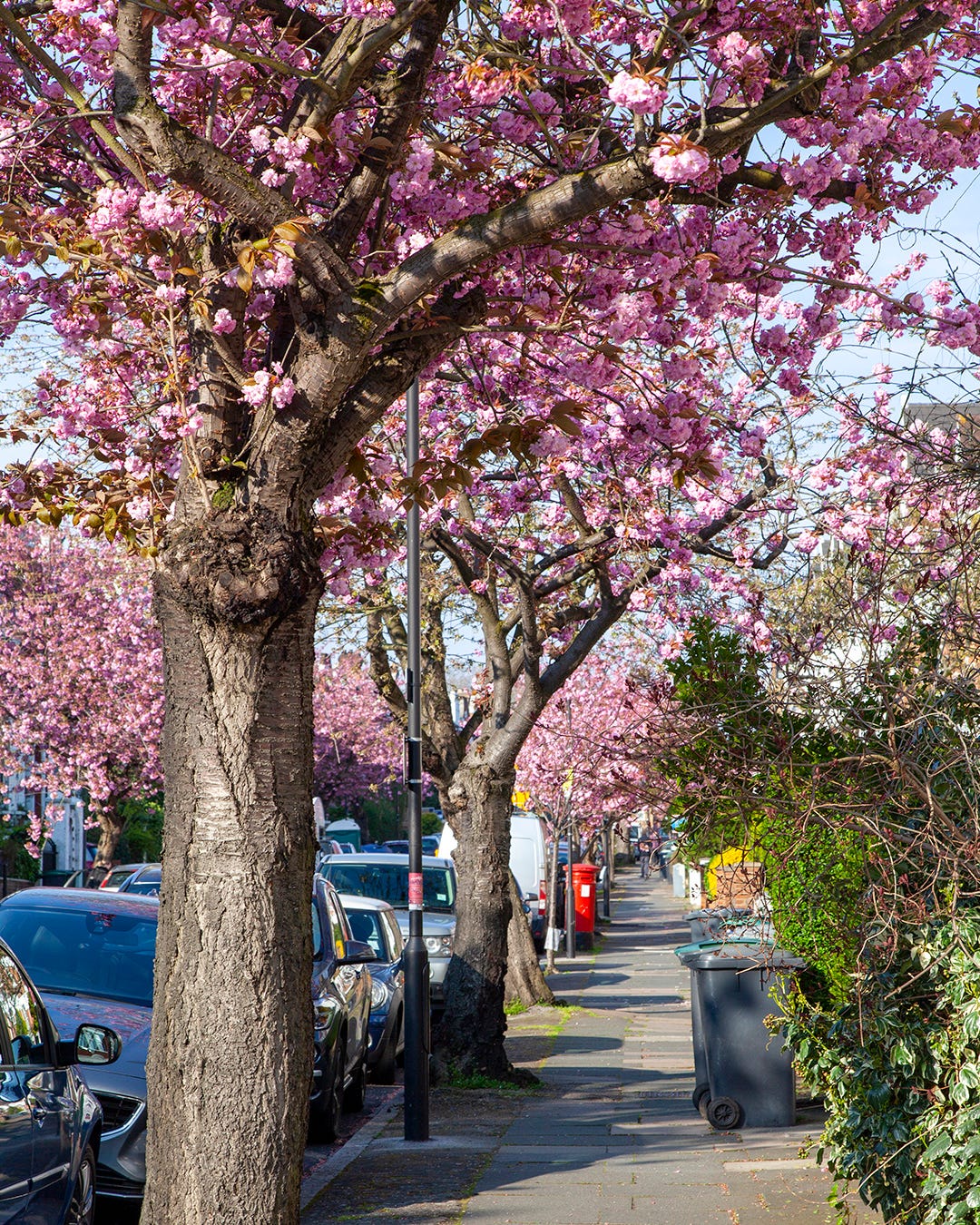Tales from the Urban Forest: The Greatest Show in Town
A blossom-gazer's guide to springtime London
Tales from the Urban Forest is a quarterly column from the writer Paul Wood, which focuses on London’s flora, fauna and its landscapes.
Paul is the author of several books about trees in London including London is a Forest, a second edition of which has just been published, and the editor of the Great Trees of London Map published by Blue Crow Media. He’s also recently started his own Substack newsletter, which you can find here:
His column deals with the city’s unregarded landmarks, the wild inhabitants who may have occupied the city for hundreds of years, the people, policies and ideas that have influenced the environment, and the precarious entanglement of humans and nature in this ever-evolving city.
In this spring instalment, Paul explains why London’s extraordinary blossom season starts way earlier than you might think it does, why our cherry blossoms are actually more diverse than those you might find in Japan, and shows you where to find some of the most beautiful examples across the city.
(P.S. If you’re a free subscriber and wondering why you’re getting an email on a Wednesday, Monday’s issue explains all.)
As March ticks on, A E Housman’s classic poem, or rather its opening line, springs to mind. ‘Loveliest of trees, the cherry now’ evokes a sense of the winter receding as London’s parks, gardens and streets are transformed by flowering trees.
Housman was referring to woodland rides in rural Shropshire, but the effect of ornamental cherry trees in the city is arguably even lovelier.
Spring blossom might be described as a rising crescendo. The first trees started flowering weeks ago, and more and more start blooming as each day passes, until peak blossom is reached sometime in April. While the crescendo builds up gradually, it gently tapers off on the other side with flowers continuing through May as spring mellows into summer.
Many different species account for the show, as blossom trees have been planted judiciously by urban foresters over the years, ensuring the spectacle is long and varied. Many are cherries, but there are also apples, pears, plums and almonds along with a few more unusual types that each play a part in the greatest free horticultural spectacle in town.
In fact, the great flowering started back in the autumn. Observant blossom fanciers may have noticed cherry trees in flower throughout the winter months, but while some may have been alarmed by this apparent effect of global warming, it is actually the winter-flowering cherry doing the thing it has been bred to do.
Like many flowering cherry trees, they are cultivars (to use the correct terminology) that have been raised by humans over generations to emphasise certain characteristics, in this case, winter flowers. Like this one, many of the most elegant flowering cherries are ones created in Japan, and introduced here in the late nineteenth and early twentieth centuries.
As Londoners know, this great city is wonderfully diverse, and this diversity extends to the types of flowering trees that abound here. Many of the dozens of different types that we take for granted originate from Japan, but in their homeland, much of that diversity has been lost and many of the trees grown in London are now very rare over there.
This lack of diversity partly explains why the Japanese have a blossom forecast giving cherry blossom flowering dates across the country. This is required because their blossom spectacle is focused on one spectacular species – the Yoshino or Tokyo cherry. This is the species of Hanami, the Japanese cherry blossom festival, and accounts for something like 90% of the cherry trees growing in Japan. In the UK, such a forecast would be difficult to achieve, as there is not a single benchmark species that defines the flowering season.
Yoshinos are one of the most elegant cherries. They have masses of densely packed pinkish white flowers, but they are rather rare in London. Occasional specimen trees have grown in odd corners of the capital for decades, but in the early 2000s, a couple of streets in Herne Hill were planted almost entirely with yoshinos.
The first is Stradella Road, a sought-after address where rumours of a disgraced prime minister buying a house swirled for months. Residents were relieved when this turned out to be unfounded, and thoughts of excruciating Hanami picnics under the blossom with Carrie and Boris were exorcised.
While the Yoshinos of Stradella Road are quite a sight, they line just one side of the street, so neighbouring Winterbrook Road with Yoshinos planted on either side (above) is the one to head for in late March. This exceptional planting scheme – a street uniformly planted with a single spectacular species – is a great role model for others in London, and is all down to the vision of one woman.
Robin Crookshank Hilton, a former local councillor, was inspired by cherry trees planted in Washington DC where she grew up. With help from Southwark council and the support of local residents, Robin was able to realise her vision of mass Yoshino planting. The effect is mesmerising and one that will only improve as the trees gradually grow into a blossom tunnel.
Yoshinos and other flowering cherries belong to the Prunus genus, one that also contains the plums, peaches, apricots and almonds. London’s flowering tree population consists of species right across this range, and here, roughly in order of their flowering, are some of the more frequent and noteworthy species.
A chronological guide to London’s notable blossoms
Apart from the winter flowering cherry, which gets going in November and doesn’t stop until April, some of the earliest trees to flower, and some of the most common, are the purple-leaved cherry plums of the ‘Nigra’ and ‘Pissardii’ cultivars that are now past their prime. They can start flowering in February and offer a good show of small, white or pink flowers respectively.
Other early flowering types are the pink-flowering ‘Okame’, and white or pink flowering almonds – identifiable by their large blooms. Both of these are quite unusual but it only takes one of these trees in full flower on a rainy afternoon in February to brighten up the day.
As March gets into its stride, the ornamental cherries also start to come into their own, several are common in the capital: ‘Pandora’, with lovely pale pink flowers; ‘Accolade’ with frillier double pink flowers; and ‘Snow Goose’ or ‘Umineko’, a distinctive goblet-shaped tree with white flowers that has been much planted on London’s streets in recent years.
As April gets going, so do the cherries. Look out for the native wild cherry or gean (the tree that must have inspired Housman), a big tree with white flowers that can give most of the Japanese cultivars a run for their money. The double-flowered cultivar (a type with two rows of petals) ‘Plena’ is frequent.
Spire cherry is also quite common and is relatively easy to identify by its long, tidy, upward-arching branches. ‘Amanagawa’ is a good cherry for a narrow street, as it maintains a neat fastigiate form. It also has attractive pinky-white flowers.
As April progresses some of the showiest, some might say overblown, species make themselves known. And they don’t come much showier than ‘Kanzan’. Big and blousy pink blooms characterise this, the classic cherry of suburbia. In North London, Cecile Park in Crouch End (above) is known to attract blossom-gazers when the ‘Kanzans’ that entirely line this street come into flower.
Competing with ‘Kanzan’ in the gaudy stakes is a new arrival, ‘Royal Burgundy’, a species with similarly conspicuous pink flowers alongside purple leaves. It is a cultivar that would make the grandfather of British cherry-tree planting, Captain Collingwood ‘Cherry’ Ingram, turn in his grave. In her excellent book, Cherry Ingram – The Englishman who saved Japan's Blossoms, Naoko Abe describes how this eccentric and privileged English connoisseur of cherry trees ensured a ‘Kanzan’ planted in the grounds of Benenden School near his home in Kent, was re-grafted with a less ‘vulgar’ cultivar.
The variety of cherry with which ‘Cherry’ Ingram is famously associated is an occasional tree in London: the ‘Great White’ or ‘Tai Haku’, a long-lost Japanese cultivar with the largest flowers of any cherry, which he rediscovered in a Sussex garden in 1932.
In May the last cherries flower, including the native bird cherry, with spikes of white flowers, and the Manchurian ‘Amber Beauty’ cherry, a species planted for its bronze bark rather than its inconspicuous flowers.
At one time, cherry tree avenues with consistently-sized trees of the same species were popular. But, while some older suburban avenues remain, this style (with the notable exception of Winterbrook Road) appears to be now out of fashion, and that feels like a huge shame.
Whole streets of flowering trees look great, but avenues of most species can be magnificent. Wouldn’t it be lovely to revive this practice?
You can follow Paul on social media @thestreettree.
Buy a copy of Paul’s book, London is a Forest.
And you can pick up the Great Trees of London map here.
If you’d like to start receiving emails like this every Wednesday then you can subscribe to LiB right here:








